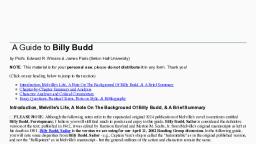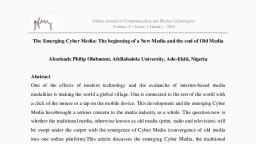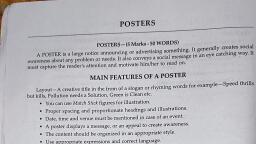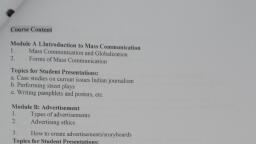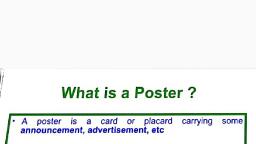Page 1 :
Guide to Making Posters and Pamphlets, , What is in this guide?, , 1. What do you use posters and pamphlets, for?, , 2. Important things to know about posters, and pamphlets, , 3. How to make a poster, , 4. How to distribute a poster, , 5. How to make a pamphlet, , 6. How to distribute a pamphlet, , 1. What do you use posters and pamphlets for?, , Posters and pamphlets are an important way of, getting information to the community. You can use, them:, , ¢ to mobilise people to support your cause, ¢ to advertise a meeting or specific event, ¢ to popularise your slogans and messages., , Posters and pamphlets are very useful especially in, areas where there is no easy access to newspapers, and radio. It is a direct way of communicating with, your constituency, but it can also be very expensive., Organisations can easily produce posters and, pamphlets but it is essential that you are clear about, the aim of the media, who you are targeting, and what, you want to achieve by doing it before spending lots of, money., , 2. Important things to know about posters and, pamphlets, , a. Posters, , Posters are seen by the target audience for only a few, seconds — usually as the drive or walk past. They, should be put up on poles next to busy roads or on, walls and windows of shops where passers by can see, them. It is important that they are as large and as bold, as possible so that they attract attention and can be, read easily. Here are some useful tips for producing, good posters:
Page 2 :
¢ Make the posters as large as possible - they should not, be smaller than A2 (4 x a normal A4 page), , « Keep the writing as big as possible so that people can, read it easily from about 10 metres away, , « Use as few words as possible - avoid using full, sentences. For example "Unite against Child Abuse", instead of "Let us unite in the fight against Child Abuse”, , e Use colour if you can afford it - it make your poster, stand out and attract more attention, , ¢ Do not put too many words and images on your poster it may be beautiful, but if the design is too busy the most, important information may not get through to the, audience, , ¢ Make sure that the poster is easily recognised as, belonging to your organisation by using your logo,, colours or the abbreviation of your organisation’s name, , Posters are generally very expensive to print but you, can make them by hand by using koki pens or paint. If, you have access to a silkscreen printer, you can also, print posters yourself. A few well made beautiful, posters can be much more effective than 100s of, small ones that nobody notices. If you want to print, posters it will cost you R2 - R4 per poster depending, on the size and quality of paper you print it on. If the, paper is thin you usually also have to use cardboard to, stick the poster onto and this will add at least another, R1 to the cost. Posters are best used for advertising, events or for popularising a short slogan that will get, support for your cause or organisation., , b. Pamphlets, , Pamphlets should be used when you want to give, people more information than you can put on a poster,, for example to:, , ¢ explain an issue to the community, , ¢ inform people of their rights, , win support for a campaign you are running, , ¢ win support for your organisation's point of view, , Pamphlets are much cheaper to produce than posters, and you can usually produce small pamphlets in A5, size (half the size of a normal A4 page) for less than, 10 cents each. You can produce pamphlets by, photocopying them yourselves or printing them ona, duplicator or by taking them to a professional printer., It is important to produce pamphlets that attract, , notch eee iii teehee Since
Page 3 :
photocopying them yourselves or printing them ona, duplicator or by taking them to a professional printer., It is important to produce pamphlets that attract, attention and make people want to read them. You, can also waste a lot of money if you print pamphlets, and then do not distribute them properly., , 1, , . How to make a poster, . Decide on the purpose of your poster, how much, , money you can spend and how many posters you, need. This will help you know how many to produce,, what quality you can afford and what method of, printing to use., , . Decide exactly what you want to write on it in terms, , of content., , . Develop a basic design and get someone who can, , use a computer to lay it out and print out a copy on, normal A4 paper — the printer can enlarge it to fit, the paper size you choose.., , 4. Remember to include the name of your organisation, , and/or logo., , 5. Make sure that there are no unnecessary words. For, , example if you want to advertise an event don’t, write "Mass Meeting, Venue: City Hall, Time:, 8.30pm, Date: 3 April” and so on. Putting Venue,, Time and Date is unnecessary. You can simple write, "Mass Meeting, City Hall, 8.30pm,3 April’. This will, enable you to write bigger letters and people will be, able to read your poster more easily. Use the, biggest size letters that you can on your poster., Look at the posters newspapers sue to advertise, every day — that will give you a good idea of what, size letters to use., , . Make your first rough draft and get someone to, , check the spelling and to proof read it carefully., , Spelling mistakes and other errors look very, unprofessional., , . Make your final copy and take it to the printers or, , organise a work session of your organisation's, media committee to hand-make your posters.
Page 4 :
4. How to put up posters, , In many areas you have to get permission from your, local municipality before you can put up posters. Get a, copy of the rules in your area and then go to the, municipality with your posters to get the permits and, pay the deposits so that the posters are not removed., , For posters that you want to stick to walls you can buy, glue or make your own by mixing flour and water. Use, a paint roller and put a thin layer of glue on the wall, and stick the poster on it., , For posters that you want to hang on poles you will, need cheap, rough string and a backing board. This, can be made out of cardboard, plastic or masonite., Backing boards can be very expensive. The cheapest, option is to use cardboard especially if you use old, cardboard boxes. You can also buy backing boards, from cardboard or packaging companies. It is a good, idea to take your old posters down and to keep their, backing boards for your next posters. . Buy 3-ply rather, than 2-ply cardboard as it will not shrivel up in bad, weather., , Cut your string into pieces of 70 - 90cms. Make a pair, of holes about 10 cms apart with a nail or a drill, through the top of the poster and another pair near, the bottom of the poster. Put a piece of string through, each set of holes. Take your stringed posters to the, poles and tie them very tightly around the pole or tree, you select. When you have tied both the top and, bottom strings around the pole, tie the ends of the top, and bottom pieces of string together. This helps to, keep the poster firm and in place regardless of the, weather., , Make maps of where the best roads are where people, are most likely to see your posters. Good positions are, where traffic slows down, like at stop signs and robots,, main roads, busy shops, bus and taxi ranks and railway, stations. Organise a team of people in your, organisation who will always put up posters as they, will get to know the area well and will know the best, sites., , Dit cin a Favs Anantara in a rau eathar than inint ann Thin
Page 5 :
Put up a few posters in a row rather than just one. This, gives people in passing cars and buses a better, , chance to read the whole poster. It also attracts more, attention. In some areas it is better to put your posters, very high on the poles as this prevents people taking, them down easily. You may need to use a ladder for, this. If your posters get damaged, take them down or, repair them soon so that you don’t create a bad, impression and your message still gets across. After, your event, take your posters down. If you had to pay a, deposit at the municipality you can get it back. Old, posters left on poles also create a bad impression that, your organisation is lazy so it is important to take, them down. Keep the backing boards which are in a, good condition for next time., , . How to make a good pamphlet, , Before you start make sure that you discuss the, purpose, the message, the target audience and the, content. Work out how many you need to print and, what quality you can afford., , If you are printing on both sides of a pamphlet each, side should have an interesting headline to get, people's attention. Each side should also carry your, organisation's logo or name. You don’t know which, side of the pamphlet people will see first and you want, them to read it even if they see the back first., , Keep your language simple by avoiding long words, and jargon. The best pamphlets are short and simple., Make sure that all your facts are right and if you are, dealing with policy issues check the contents with, your organisation's leadership., , Do not make the layout too dense with lots of small, typing. Leave some space in between the writing, either as empty white space or as space for logos or, pictures. This makes it easier for people to read. Most, computers have different fonts [kinds of type face]., Check which are easiest to read and use them. You, , can also vary the typing by using bold and italics as, well as different size letters for headings, captions and, so on. Play around with this until your media, committee agrees on the best layout. Use bold, headlines that catch people's attention and sound, interesting.

